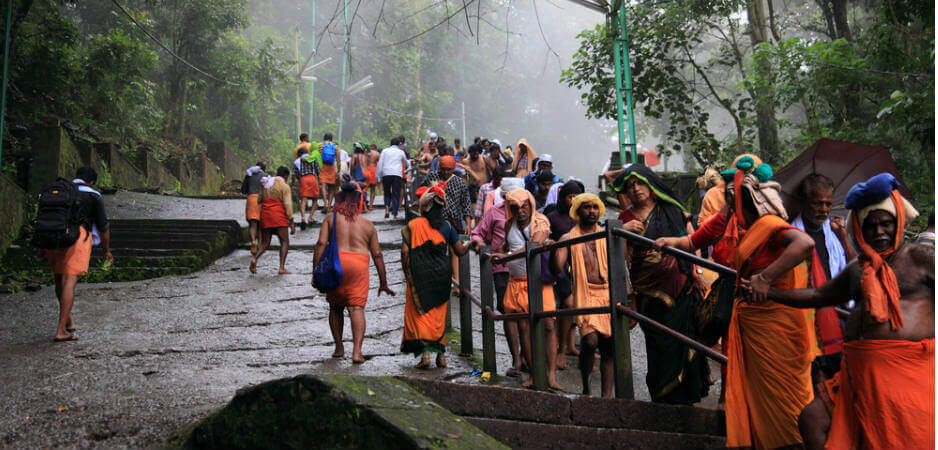It is only a matter of time before women are free to enter the Hindu temple of Sabarimala.
On September 28, the Indian Supreme Court voted 4:1 in favor of doing away with the centuries-old ban that barred girls and women aged 10 to 50 from entry into the Hindu Sabarimala temple in Kerala. Chief Justice Dipak Misra ruled that “Patriarchy in religion cannot be allowed to trump right [sic] to pray and practise religion.” Justices Chandrachud, Khanwalikar and Nariman all agreed with the chief justice that the practice of excluding women of certain age is discriminatory in nature. The lone dissenting opinion was from the only female judge on the bench, Justice Indu Malhotra. “Notions of rationality cannot be invoked in matters of religion,” she concluded, adding that “what constitutes essential religious practice is for the religious community to decide, not for the court.”
The Sabarimala temple, one of Hinduism’s holiest shrines that attracts millions of pilgrims each year, follows a very specific calendar of when it is open to devotees. It is the abode of Lord Ayyappa, the 12-year-old god who is forever a brahmachari, or a celibate. Legend has it that Lord Ayyappa was born out of the union of Lord Shiva and Lord Vishnu, who had assumed the female form of Mohini in order to kill the demoness Mahishi. In his human incarnation, Lord Ayyappa was the son of the king of Pandalam, Raja Rajasekhara. After fulfilling his divine duty to vanquish Mahishi, Lord Ayyappa is said to have assented to the king’s wishes to build a temple dedicated to him. He is worshipped by Hindus for his strict adherence to dharma — the path of righteousness.
The scene at the temple during the opening immediately following the court ruling was nothing short of chaos. Despite the Supreme Court verdict, women who attempted to enter the temple were stopped by protesters. The temple is closed again and will reopen soon for its busiest worshipping seasons, Mandala Pooja and the Makaravilakku festival. (Mandala Pooja at Sabarimala is the period devotees visit the temple to offer their prayers after observing a strict code of austerity for 41 days, and it typically occurs from mid-November to end of December. Makaravilakku is observed on the first day of the Malayalam month of Makara, typically between January 14 and 16.) Petitions have been filed challenging the ruling, and the Supreme Court has set the hearing for November 13, even as protesters vow to defy the current ruling and keep women away from the temple.
Body and Soul
Prior to the Supreme Court ruling, the general information page on the temple’s website stated: “As Sabarimala Ayyappa is ‘Nithya Brahmachari’ (celibate) women between the 10-50 age group are not allowed to enter Sabarimala. Such women who try to enter Sabarimala will be prevented by authorities.” This sentence has been removed since the court verdict. As a rule, if celibate gods cannot be worshipped by women, there would be much anguish and chaos amongst Hindu religious circles and devotees. After all, the Hindu God Hanuman, also a brahmachari, has no restrictions on being worshipped by women of all ages. Lord Hanuman, a passionate devotee of the Hindu God Rama and his wife Sita, is worshipped for his strength, energy and unyielding devotion to Lord Rama. One would be hard pressed to find an instance in mythology where Lord Ayyappa himself forbids young women from worshipping him.
According to legend, upon slaying Mahishi, when the beautiful woman ensconced in the demoness’ body emerged and asked to marry him, Lord Ayyappa declined. However, Ayyappa did mention a condition under which he would marry her. Should it ever come to pass that no new devotee comes to worship him in any given year, Lord Ayyappa said that he would marry the girl. The decision to bar women from entering the temple is, apparently, not by the God himself, but by the men of the gods.
Men who visit the temple have to observe a vrutham, a penance of sorts, practicing the celibate life of a brahmachari and abstaining from alcohol and other worldly pleasures in preference to prayers and a pious lifestyle for 41 days. It is considered a sacrilege to attempt to visit the temple without observing the vrutham, which prepares a devotee physically, emotionally and mentally to worship Lord Ayyappa. Devotees are required to be pure at heart and in body before undertaking the journey to Sabarimala. The requirement that a devotee has to be pure in body poses the obstacle when a woman between the age of 10 and 50 wants to visit Sabarimala.
Girls and women in that age group are not considered pure because of menstruation. While every other bodily function that men and women have little control over is considered acceptable, menstruation, unique to women, is considered impure. From a young age, boys and girls are taught to believe that women are lesser — and dirtier — than men on account of menstruation. The subject is a taboo in most cultures around the world, but especially so in India and in Hinduism. In most households, women are virtually ostracized during their periods. They are not allowed to enter the kitchen or to cook, forbidden from going into temples, are served food in separate plates while they “sit out” the three days without touching anything or being touched by anyone.
Buying a sanitary napkin in India tends to be an embarrassing experience both for the buyer and the pharmacist. While women are making great strides in unshackling themselves from the taboos around their periods, the notion that menstruation is dirty and women are impure is still deeply entrenched in Indian society. Strong resistance to allowing women from entering the Sabarimala temple in complete defiance of the Supreme Court verdict is case in point.
A Matter of Time
In a press interview in 2015, former president of the Travancore Devaswom Board, the governing body of Sabarimala temple, Prayar Gopalakrishnan, fuelled the long-standing controversy stating that women will be permitted entry into the temple if a machine is invented to judge and scan their purity. In an equally bizarre statement, Smriti Irani, an educated woman who has risen through the political ranks to become the union minister of textiles in Indian Parliament, went as far to ask, “Would you take sanitary napkins steeped in menstrual blood and walk into a friend’s home?” Women like Irani and men like Gopalakrishnan typify the reasons why the fight against patriarchy is as much a fight with women steeped in its philosophy as it is with men and their beliefs.
Justice Chandrachud explains why the judiciary is entertaining the contentious and emotionally charged topic of balancing individual rights against the customs and practices of religious groups. In his consenting opinion, he likened the ban on women from entering Sabarimala temple to a form of untouchability. “Exclusion of women because she [sic] menstruates is utterly unconstitutional,” he said, confronting the taboo subject head on and highlighting that the “popular notion about morality can be offensive to dignity of others.”
It is heartening to see such clarity of thought from the bench of the Indian Supreme Court in recognizing women’s rights, striking a strong blow at the very core of patriarchy. Women should take heart that it is only a matter of time before they are able to enter the Sabarimala temple, once closed to them. They should be free to worship Lord Ayyappa at Sabarimala temple much the same way they can offer their prayers to Lord Hanuman today.
The views expressed in this article are the author’s own and do not necessarily reflect Fair Observer’s editorial policy.
Support Fair Observer
We rely on your support for our independence, diversity and quality.
For more than 10 years, Fair Observer has been free, fair and independent. No billionaire owns us, no advertisers control us. We are a reader-supported nonprofit. Unlike many other publications, we keep our content free for readers regardless of where they live or whether they can afford to pay. We have no paywalls and no ads.
In the post-truth era of fake news, echo chambers and filter bubbles, we publish a plurality of perspectives from around the world. Anyone can publish with us, but everyone goes through a rigorous editorial process. So, you get fact-checked, well-reasoned content instead of noise.
We publish 2,500+ voices from 90+ countries. We also conduct education and training programs
on subjects ranging from digital media and journalism to writing and critical thinking. This
doesn’t come cheap. Servers, editors, trainers and web developers cost
money.
Please consider supporting us on a regular basis as a recurring donor or a
sustaining member.
Will you support FO’s journalism?
We rely on your support for our independence, diversity and quality.






